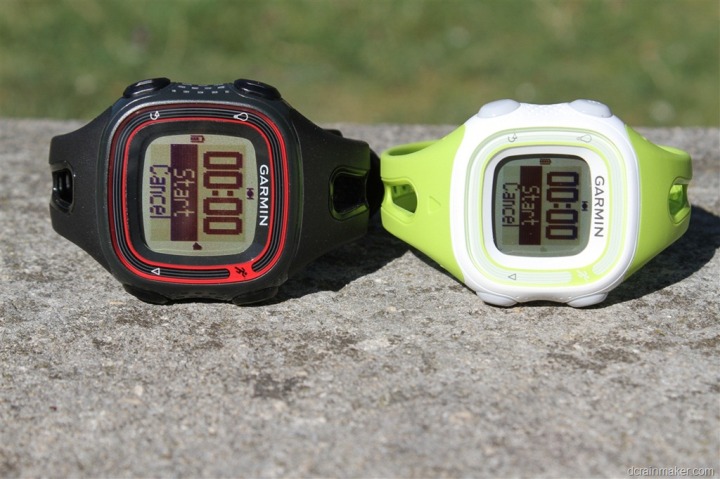
Today Garmin announced the new Garmin FR10 GPS watch. This watch has one purpose, and one purpose only: To compete with the onslaught of $100 GPS watches. From features and functionality to sizing – everything is smaller than other Garmin watches. But, for those looking for a low-priced GPS watch that’s more durable than a cell phone – this line definitely opens up new options.
I’ve been using two units now for a bit, and have been able to get used to all their functions and how they work. Additionally, The Girl also has been using one. Appropriate since one of the two watches is smaller and targeted towards women. So how well did Garmin do in getting out this low-price GPS product? And how does it stack up against the other competitors in this space? Well, let’s dig in and find out.
Because I want to be transparent about my reviews – Garmin sent me two units to try out. These are final production units with final firmware. Once units are available in retail shops I send them back to Garmin and then go out and buy my own (to be able to support y’all in the comments section down the road). Simple as that. Sorta like hiking in wilderness trails – leave only footprints. If you find my review useful, you can use any of the Amazon links from this page to help support future reviews.
Lastly, at the end of the day keep in mind I’m just like any other regular athlete out there. I write these reviews because I’m inherently a curious person with a technology background, and thus I try and be as complete as I can. But, if I’ve missed something or if you spot something that doesn’t quite jive – just let me know and I’ll be happy to get it all sorted out. Also, because the technology world constantly changes, I try and go back and update these reviews as new features and functionality are added – or if bugs are fixed.
So – with that intro, let’s get into things.
Unboxing:
The Garmin FR10 is the first GPS watch from Garmin using a new half-sized box. Given how much space the other ones took up, this likely saves them considerably on shipping costs from the factories in Asia.
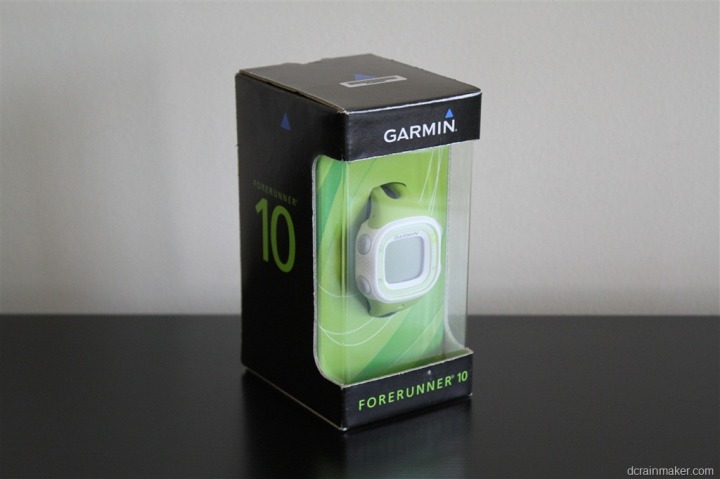
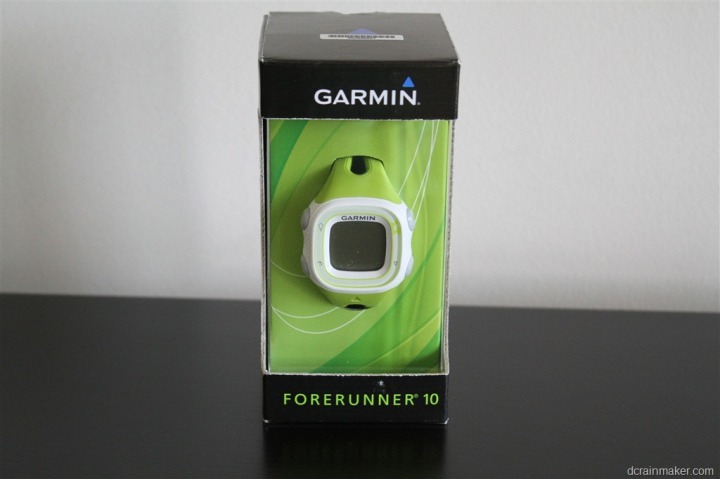
Inside you’ll find simply the unit and the USB charging/downloading cable. It’s likely that this was a non-final box, so I suspect you’ll also find some additional paper junk down the line. But for now – you’ve got the two things you care about.
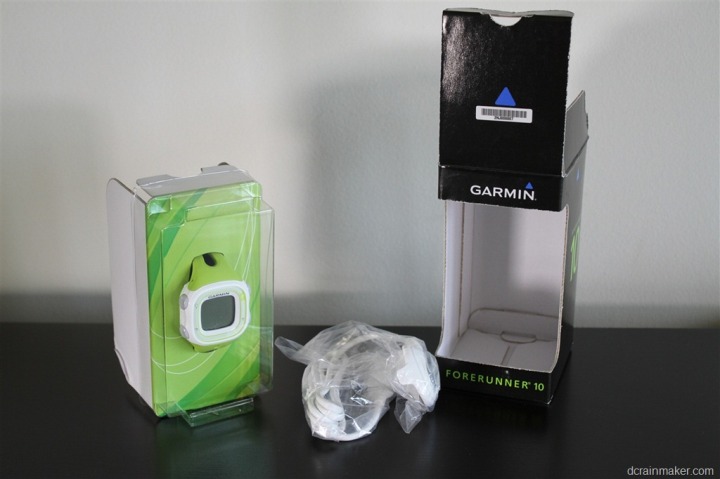
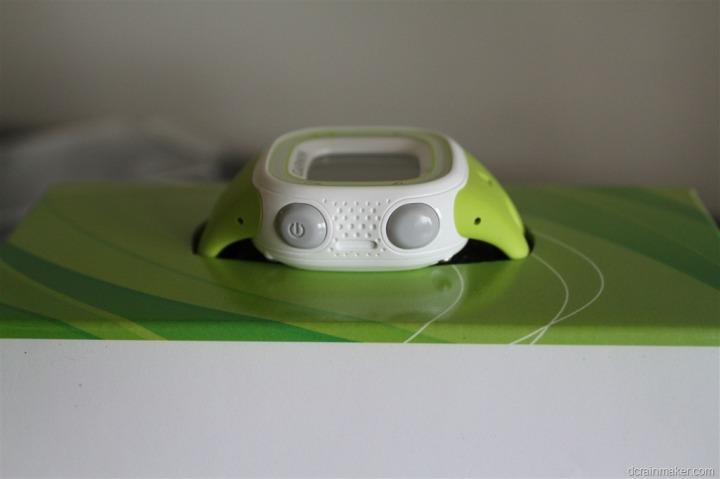
First up is the watch itself, which comes charged though turned off. There’s three versions – the black/red one below, the green/white one (also below), and a pink version. No pink version below.
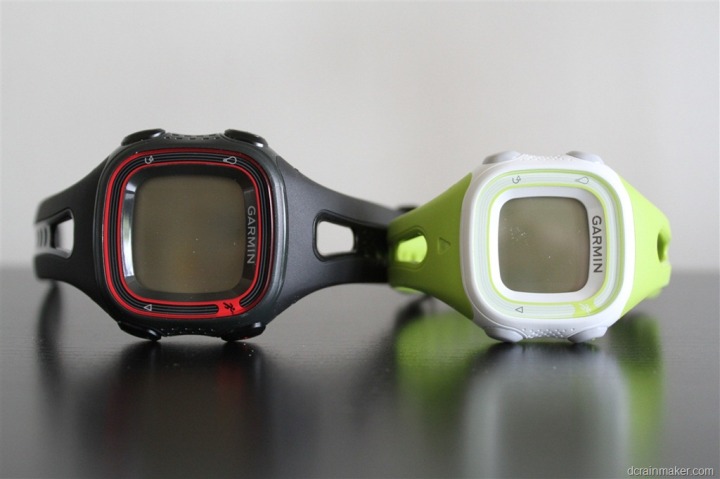
Then we’ve got the small USB charging cable. There’s no additional power block for the wall, so you’ll need to find your own USB port somewhere. The USB charging cable is what’s also used to download data from the unit and upload it to Garmin Connect:
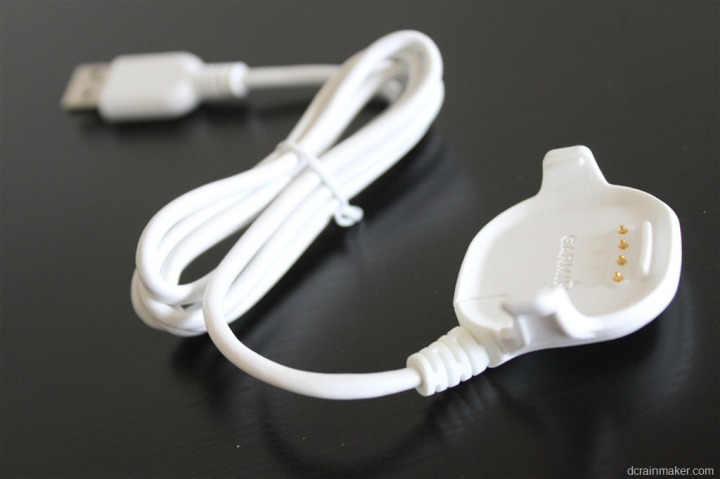
Now, here’s an important item to note – the colors (flavors) are actually different sizes. Yup, seriously. Check out the watch bands and size of the face itself:
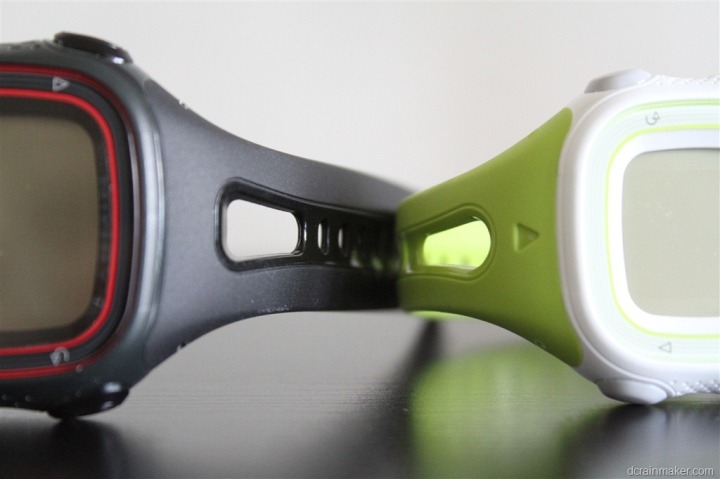
The green watch is a touch bit smaller – enough such that the charging clips won’t match. For us (me and my wife), that’s a pain in the butt because we often have similar watch models and therefore on trips only have to worry about one of us carrying a charger.
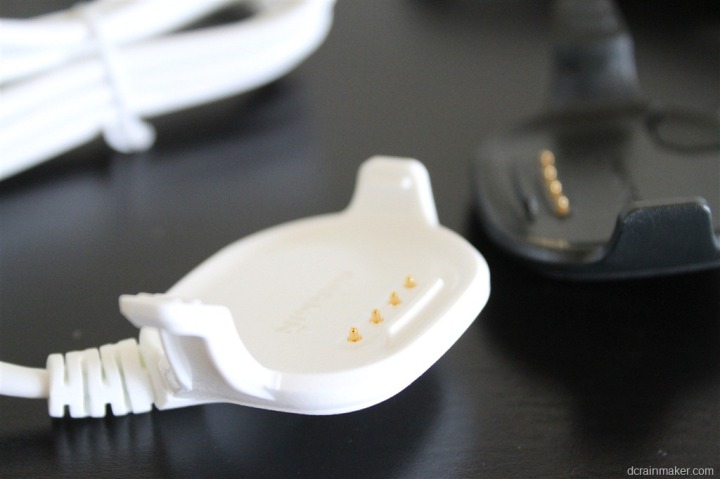
The USB charger attaches via a clip that snaps onto the back of the watch. Garmin continues to improve in this area. While this isn’t quite as secure as the most secure charging clip I’ve seen from Garmin (the new Fenix clip) – it’s still pretty solid. Definitely would survive being tied onto a ceiling fan and swung around.
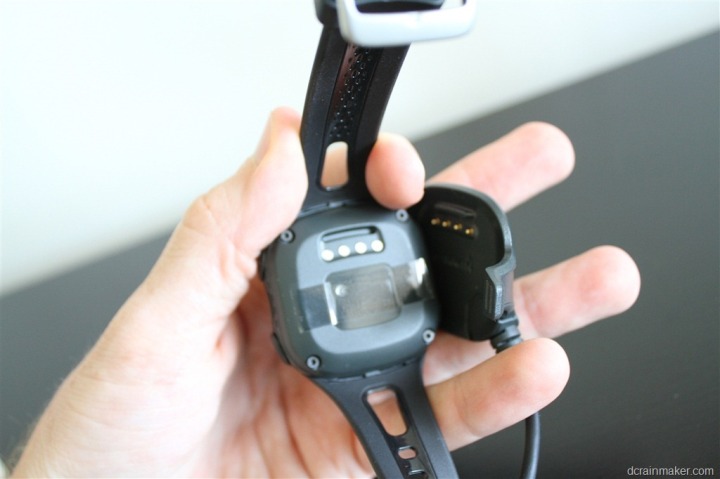
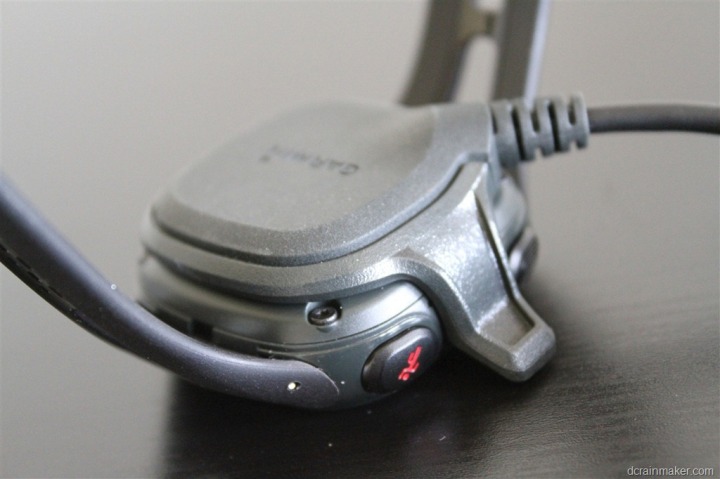
With everything unpacked, it’s time to do a quick size comparison before moving into actual use.
Size Comparisons:
As always, I like to put together sizing comparison with other units in the same rough price range. In this case, I’m looking at watches between $100 and about $130 that seemed appropriate. All but the Garmin FR70 have GPS. As a general reminder, these are all watches I’ve bought – so if it’s not there in the lineup, it’s likely because I don’t have one and haven’t reviewed it. Additionally, there’s only so much room on that rolling pin.
From left to right: Garmin FR70, Garmin FR10 (green/women’s), Garmin FR10 (black/men’s), Timex Marathon GPS, Soleus 2.0 (note: Soleus 1.0 is exact same casing, thus identical in size except colors are changed).
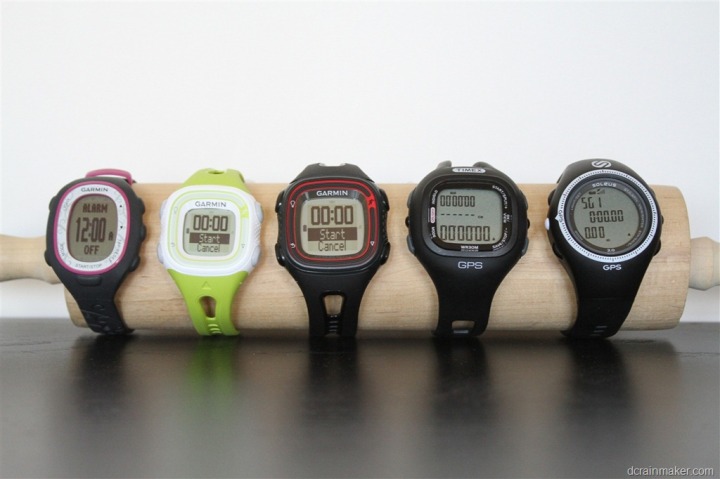
Here’s a look at the thickness of each one. You can see that in general they get slightly thicker from left to right.

And then again, inverted on the counter – so you can see the air gaps under each one.
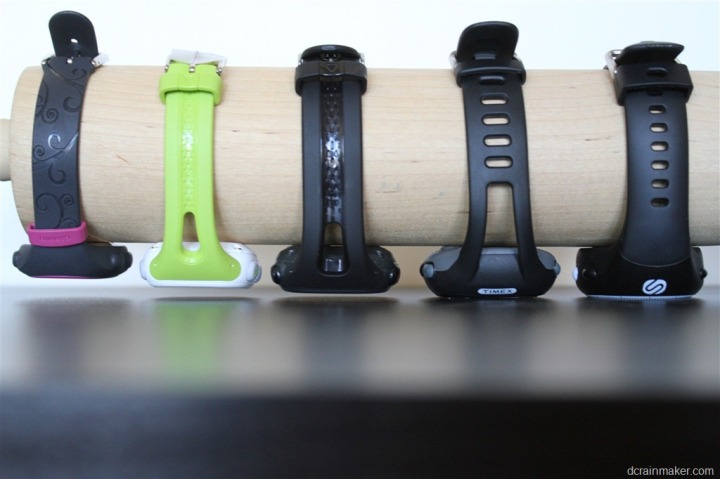
Many times I’m asked for what the watch sizing looks like on a small female – especially one with small wrists. Thus, ask and you shall receive. On her other wrist she’s wearing the Garmin FR310XT – which is her watch she normally runs with.

As you can see, the green watch is a fair bit smaller. Though she notes she doesn’t mind the larger FR310XT size and simply has gotten used to it. But she’s more of a competitive athlete and wants the additional data.
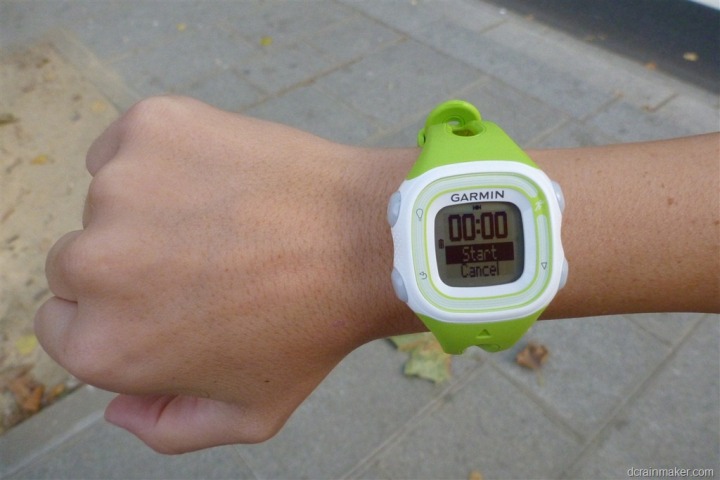
Overall I think Garmin did a good job at decreasing the size here for the women’s watch. Both of us would have probably preferred it be slightly wider if they could have made it thinner – but this certainly isn’t bad given the budget nature of it.
Update: April 2013: Garmin has also now added an orange version (Men’s larger size), as well as a purple and neutral version (Women’s smaller size). I took two photos of these and placed them next to their other similarly sized siblings:
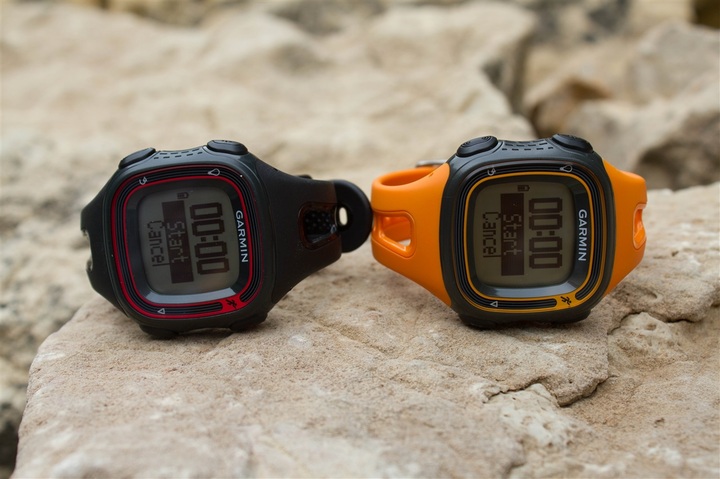

Running:
To start off with your run, you’ll simply tap the upper right button – which starts the GPS satellite acquisition phase. The first time this may take a minute or two, but as long as you’re starting in roughly the same place next time, it’ll be within about 15-30 seconds.
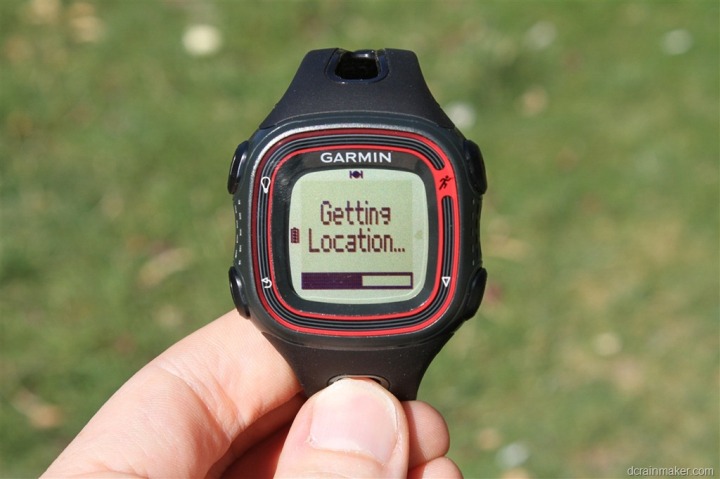
After that, you’re pretty much ready to run! To do so, simply tap the start button again and it’ll start recording.
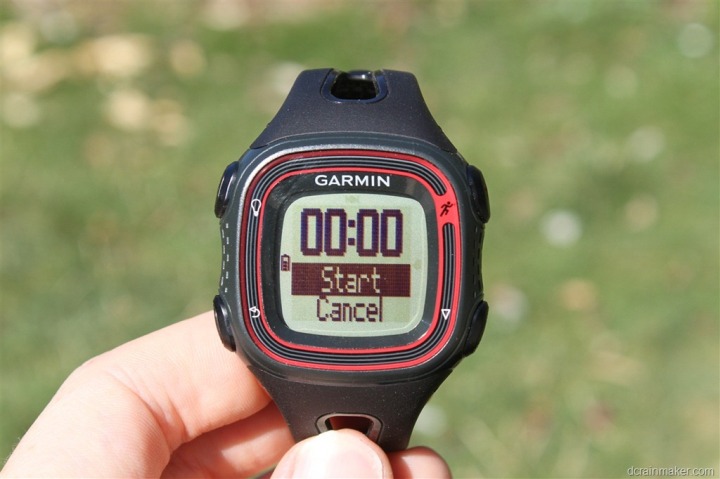
You can configure two data pages on the FR10, each with up to two pieces (tied together) of information on them.
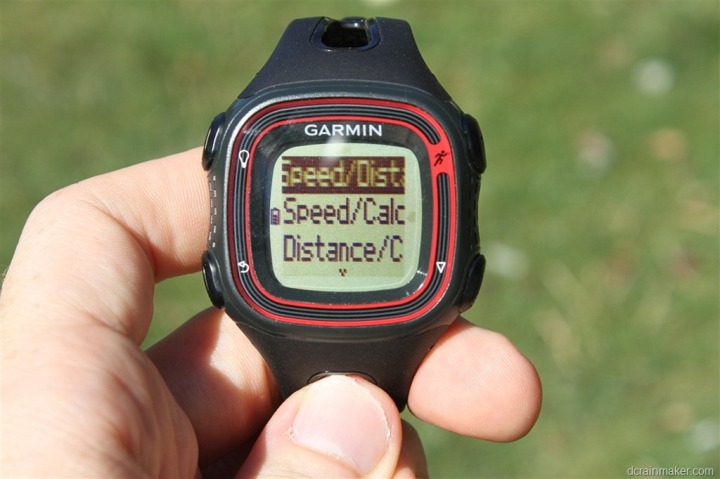
The choices are as follows (they come in pairs, you can’t get one without the other, pick two pairs):
– Time/Distance
– Time/Pace
– Time/Calories
– Pace/Distance
– Pace/Calories
– Distance/Calories
Also, Pace/Speed can be displayed in one of the following formats (applies to all pace displays above, you don’t get to mix and match):
– Pace
– Lap Pace
– Avgerage Pace
– Speed
– Lap Speed
– Average Speed
(Note: Updated Sept 10th, 2013 with Average Pace additions)
So above, you’d choose one line which then puts the two data metrics on a single page. And then choose another line for your second page. Two pages total. No more, no less.
While running, you’ll simply press the lower right button to scroll between the different data pages. Additionally, if you’ve got some of the other functions enabled (like Virtual Pacer) – that’ll show up as well as an additional data field. But more on that in a minute. Below is what the data fields look like while running:
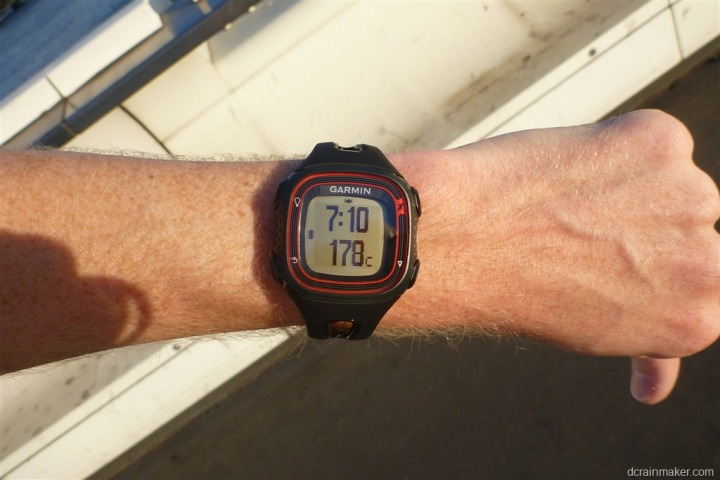
If you’d like to set a lap (marker/interval) – which triggers a lap being set. You can also set auto-lap, which I’ll go into in detail in a second.
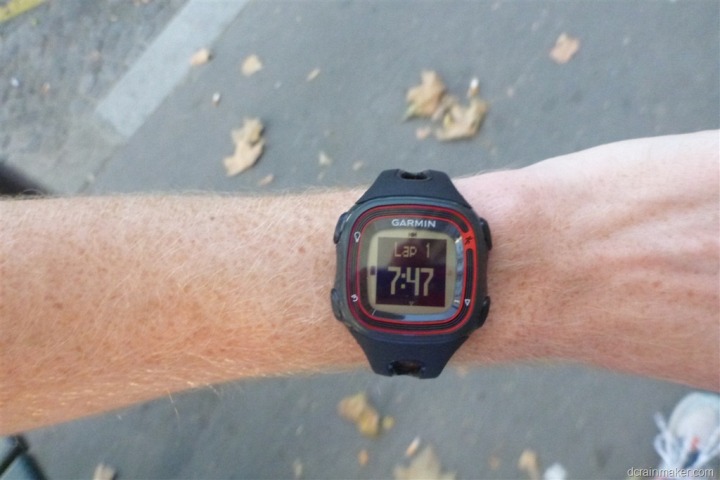
These lap markers are visible in both the device history, as well as uploaded to Garmin Connect.
Virtual Pacer Function:
Virtual Pacer allows you to specify a goal pace (i.e. 7:45/mile) and then the watch will alert you when you’ve gone too fast or too slow.
This feature actually works a bit differently on the Garmin FR10 than the rest of the Garmin lineup of watches. Neither better or worse per se, but a bit more simplified.
First, you’ll go into the Virtual Pacer menu and configure the pace you’d like to set. If you’re in miles mode, it’ll configure it in minutes/mile. If in kilometers, then minutes/kilometer:

Once you’ve started your run, you’ll notice that you have an additional screen that shows your current pace and whether you’re ahead or behind the actual pace. There’s a tiny bit of lag built in (perhaps 5-10 seconds) – but that’s probably a good thing, as I’ll explain in a second.
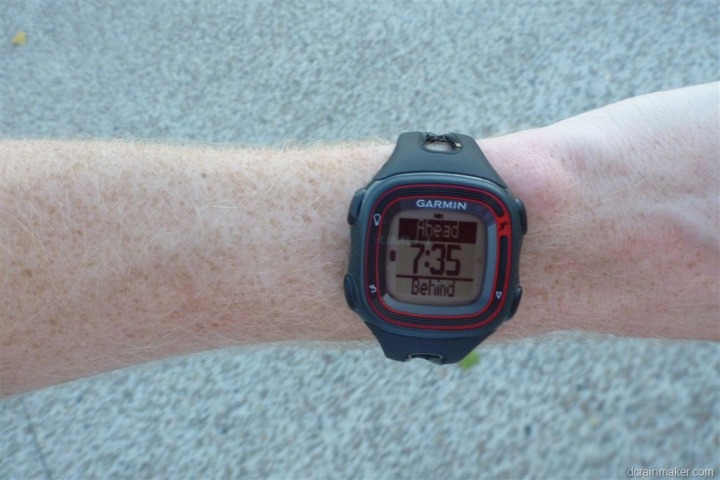
In addition, if you’re set to display one of the other data pages, then it’ll throw up an alert if you’re ahead/behind pace. As well as beep:
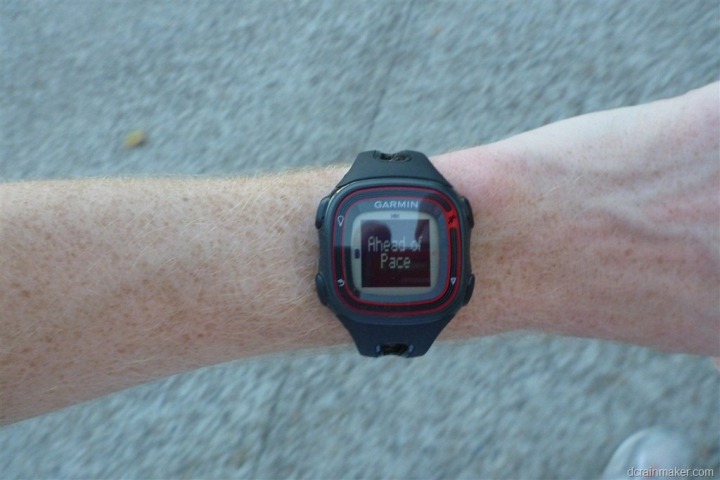
What’s funny here is that I had set this before one of my runs – merely as a way to get pictures for the review and understand how it works – not so much because I wanted to run a 7:45 pace that run. But in reality, the darn thing was so persistent when I got off that pace, that I just didn’t want to hear it any more – so I ended up running a 7:45/mile pace that evening merely so I wouldn’t have to hear it anymore. It was far more persistent and loud than other units. Which I suppose is a good thing.
In an effort to show you what this looks like, I took this video running over the top of a bridge over the Seine. Because this wasn’t a flat bridge, I was slightly uphill at the start and then downhill towards the end – perfect for showing how the Virtual Pacer works:
Garmin Virtual Pacer Function Video
Now, this differs from other Garmin units which show you how far behind/ahead you are (in distance/time). Thus, not quite as much information as those, but also a bit more straightforward. Make sense? Good.
Walk/Run Function:
The walk/Run function is targeted at those who may be using training plans that incorporate walking into the long-distance running – typically for a short period of time like a minute. These plans have become vastly more popular in the last few years.
In the case of the FR10, you’ll configure a run duration (time only), and then a walk duration (time only). The watch will automatically alert you when you reach the end of either duration.
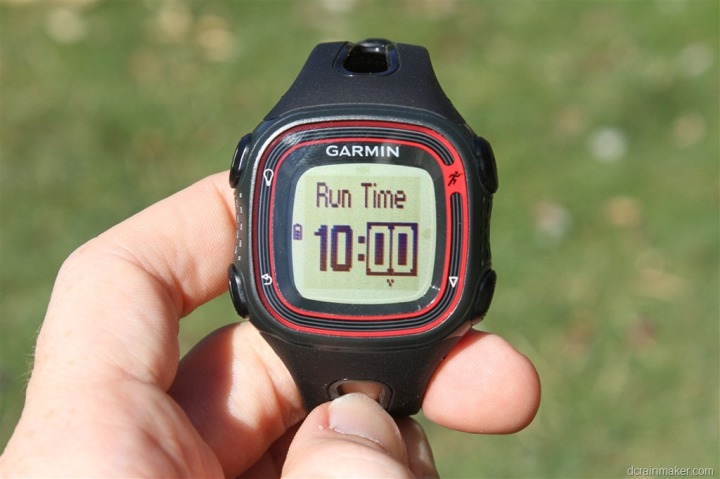
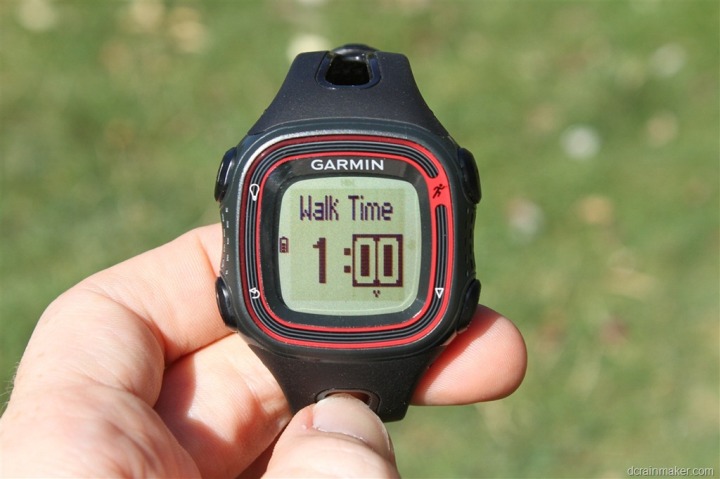
It’ll simply repeat this over and over until you complete the activity.
This functionality was first introduced on the Garmin FR610 (a $400 watch), so I’m happy to see it drop down to their cheapest watch. Given the target audience, I’ve always thought it was odd we haven’t see it in later firmware updates for other mid-range watches (i.e. Garmin FR210) – maybe that’ll change now.
Auto Lap Function:
Auto Lap will automatically set a marker/lap at the end of a given time period – as defined by you. By default if you enable it, it’ll be every 1 mile. These laps then show up later on in history as well as Garmin Connect. Additionally, it’ll alert you during the run as you cross over the threshold of each lap (audibly/visually).
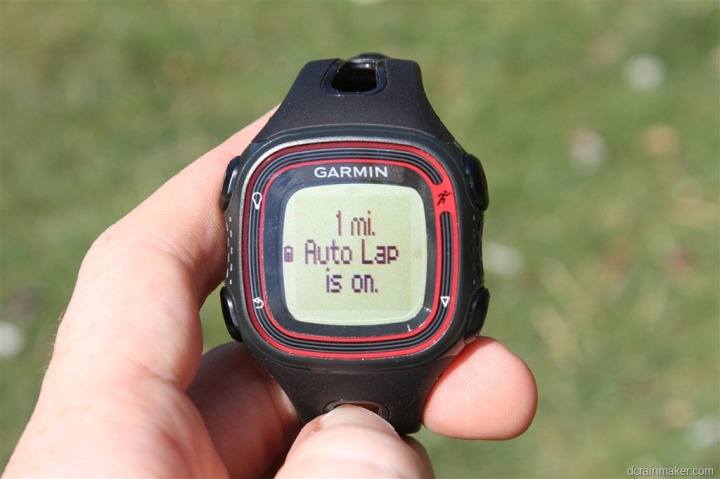
Auto Pause Function:
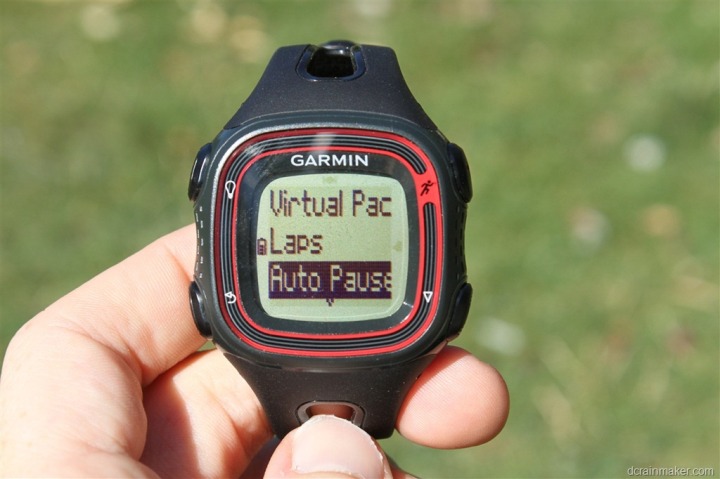
Auto Pause lets the watch take control of pausing the recording while your waiting to cross at an intersection. Whenever you drop below the speed threshold (roughly a slow walk), the unit will automatically pause the timer/recording.
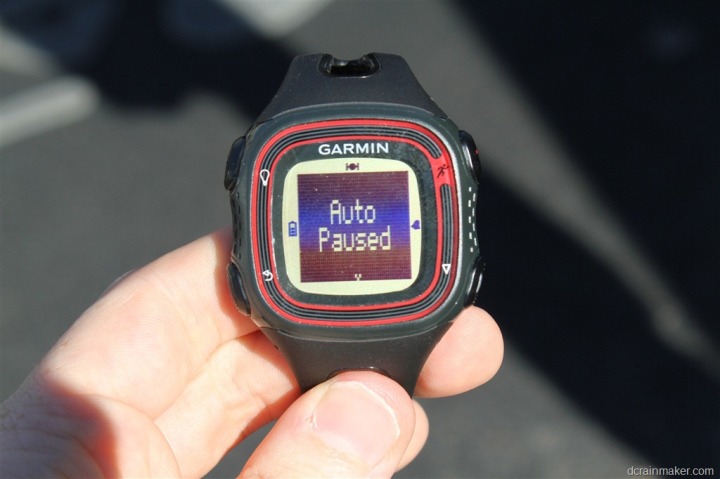
This is primarily useful if you’re doing a lot of city running with a fair number of stoplights/signs. Once you start walking fast and/or running again – it’ll kick back on and resume recording.
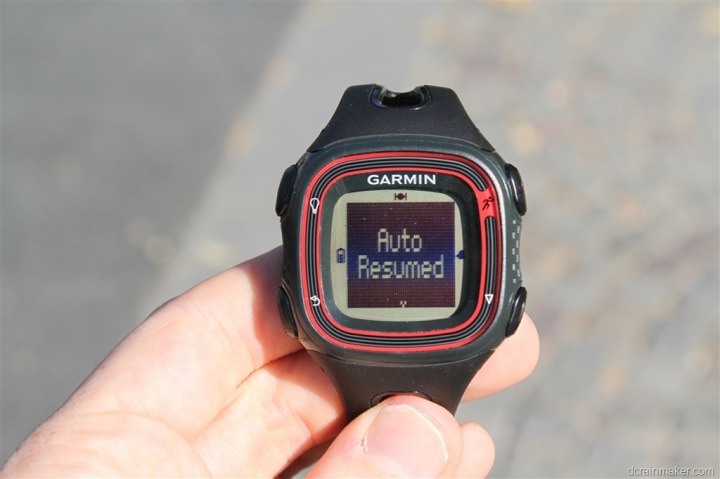
I don’t tend to use this myself, as I’ve gotten fairly good at just pausing manually when I want it to (by pressing the upper right button on the unit), and then resuming manually. To each their own though.
Cycling:
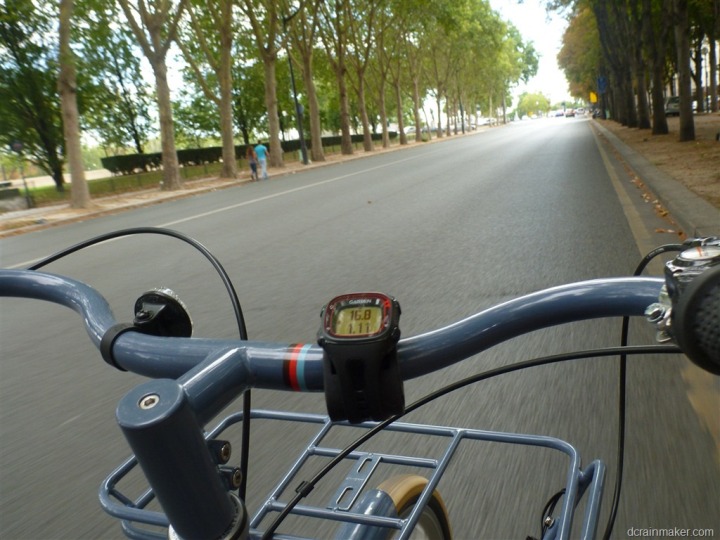
The FR10 supports cycling…but only just barely. Like a kid eating only about two bites of his vegetables. It supports cycling by merely supporting the ability for you to change the velocity metric from ‘Pace’ (i.e. 7:45/mile) to ‘Speed’ (i.e. 20MPH).
That’s it.
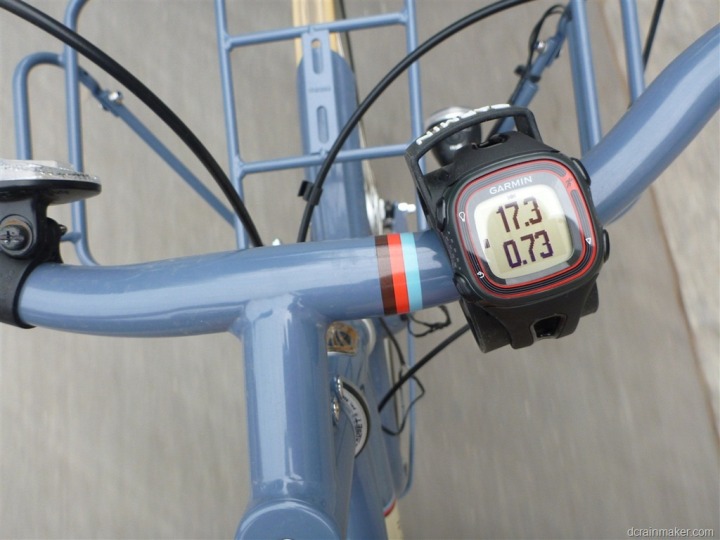
It won’t record your workouts as ‘bikes’ for Garmin Connect to pickup, nor will it even tell you ‘Bike completed’ (it says ‘Run completed’) at the end. Of course, you can easily change the workout from run to bike later in Garmin Connect with a simple dropdown on the site.
Now, to be fair – this is no different than other units in this price category. And additionally, all of the functions noted above in the running section still work just fine in cycling mode. It’s just that for example, you can’t specify a Virtual Partner ‘Speed’ of 15MPH, rather, you’d have to enter it in as 4:00 min/mile.
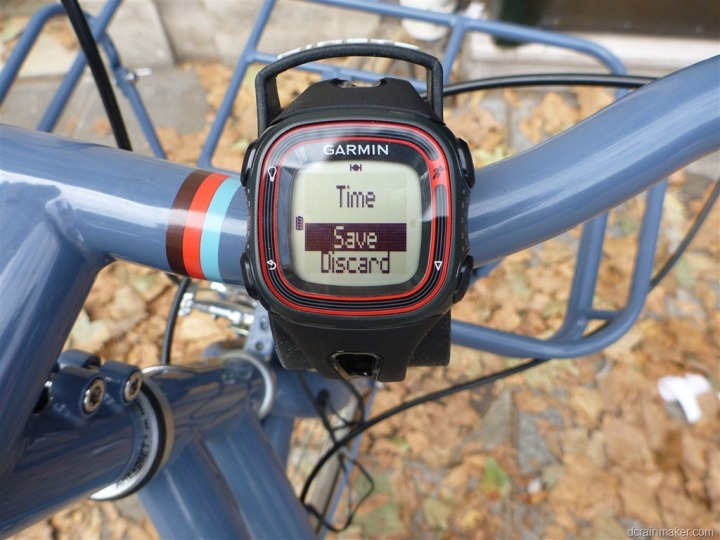
Still, if you cycle occasionally – or just want to use it around town, it works just fine for recording all your cycling data without issue. And, it’ll easily upload to Garmin Connect for later analysis. Since it records all the same GPS data as a watch four times it’s cost – it doesn’t really matter as much that it mis-categorizes it.
Note that the unit will NOT work with any ANT+ bike sensors (speed/cadence), nor any ANT+ power meters, nor any Polar W.I.N.D. cycling sensors. Really, no external sensors at all. Just wanted to clarify that point.
Waterproofing/Swimming:
Finally. Holy mother of cowbells finally. Someone at Garmin finally got it. They grasped that a GPS watch costing hundreds of dollars (or roughly a hundred in this case) should have the same waterproofing as one costing $15 at Walmart. As they say in New Zealand: Give that man (or woman) a chocolate fish!
And thus, the very first running specific GPS watch from Garmin to include legit waterproofing. None of this IPX7 garbage that they use on watches costing four times as much. Ironically enough, introduced on their cheapest GPS running watch.
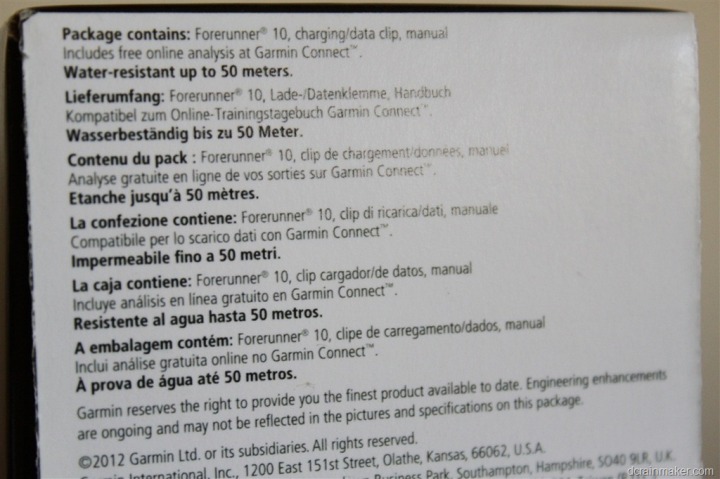
(You’re noticing the waterproofing to 50 meters deep)
This means it’s completely OK to swim with – something we tested out at the pool last week by swimming with it on our wrists the entire session. And happily, it worked just fine and has been working since.
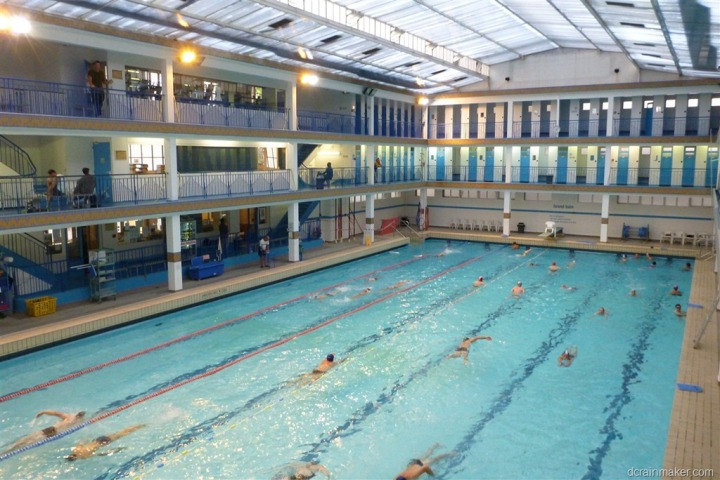
This also means that you’re completely cool with using it in the rain or other watery adventures – so long as you’re not below 50 meters. Now the real important part of this isn’t actually that you can swim with it. Rather, it’s that it stands a far better chance of day to day water survival – an issue with the IPX7 rated watches that while rated fine for use in the rain, tended to have issues more than those with higher ratings.
Of course, in the pool it’s doing nothing more than hanging out in ‘Indoor mode’ – so only tracking time as a lap meter. But still, better than drowning (the watch, not you).
Indoor Mode:
Speaking of indoor mode, I thought I’d briefly mention it. If you’re hanging out inside and just want a simple timer with lap/interval functional – and don’t care about GPS, then you can go ahead and just tap the lower right button when it starts searching for GPS, which will bring it to this screen:
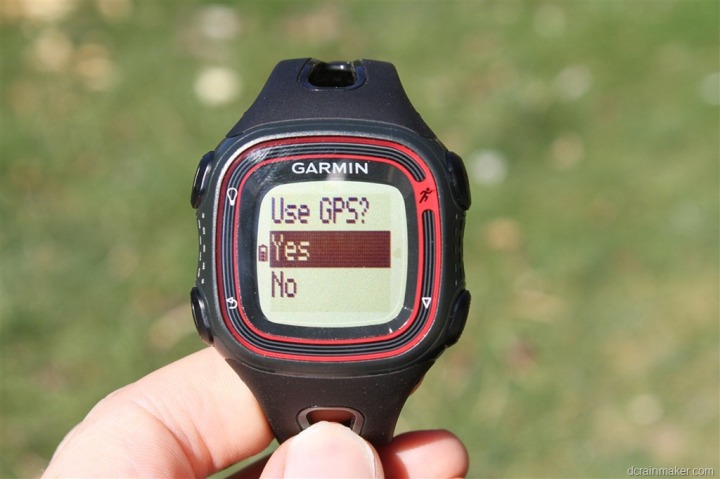
From there, simply tap ‘No’ to have it go to the timer start page. Note that you won’t get calories here, or distance, or pace, or anything else other than time. Since there’s no ANT+ sensor support, you can’t get other data streams to aid in those metrics. Make sense?
Backlight:
The Garmin FR10 includes a basic backlight on the unit. I wouldn’t exactly say that the backlight on the FR10 is terribly brilliant in comparison to some of the other Garmin watches (like the FR910XT). But it gets the job done and is more than enough.
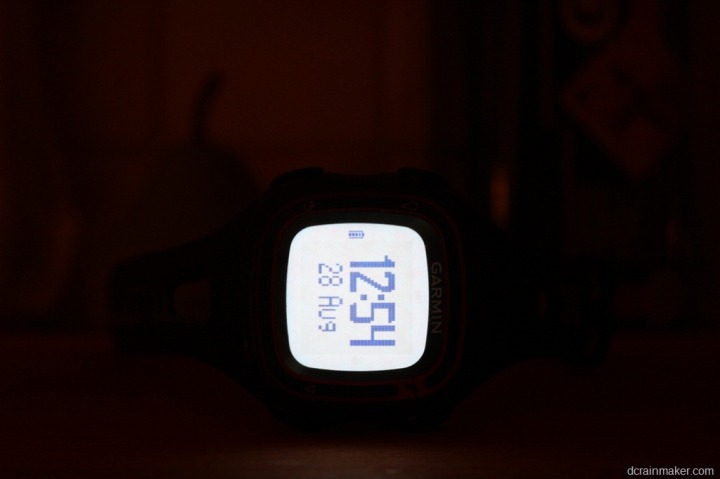
You can turn on the backlight by tapping the upper left corner button, which then turns it on for 10 seconds, before turning it off. You cannot set the unit to leave the backlight on.
You cannot adjust contrast or brightness on the watch either.
Accuracy/GPS Instant Pace Stability:
First, let’s start with GPS instant pace stability. This is how stable the instant pace feature is on the watch when you run at a near-perfect constant pace. Does the GPS show that same constant pace? Or does it waver like a flag in a hurricane?
It seems as over the past 1-2 years, GPS instant pace display across a number of companies has gone down the crapper, so earlier this summer I started doing videos on all units that I’m reviewing – letting you decide if it’s crap or not.
I think it’s fair to say after you see the video below – that you’d likely agree the FR10 is the most stable instant pace watch ever seen. Heck, it might be so stable you’d think it’s simply stuck on the numbers. But I’m really impressed. Check out the video:
Garmin FR10 Instant Pace example
Which leaves me with one question/comment/statement: Garmin, please take whichever developer fixed this and put him on a solo-project dedicated to fixing it on every other watch of yours. Really, a lot of people would be happier. Like crazy happier.
As for accuracy – we were generally satisfied with that too. I’ve taken it out for a few runs, including one with The Girl, where we both ran together and both with two watches. I ran with the Polar RC3 beta watch, she ran with her trusty FR310XT, and we both ran with FR10’s. At the end of the run, here’s what we say:
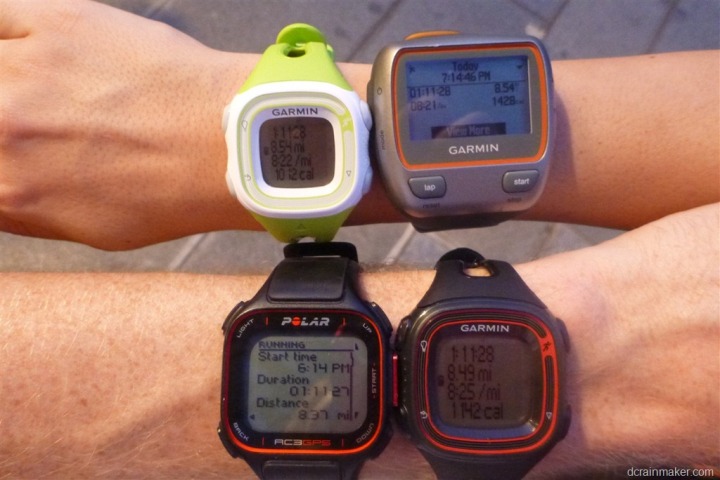
In short, the numbers were:
Garmin FR10 Green: 8.54 (The Girl)
Garmin FR310XT: 8.54 (The Girl)
Garmin FR10 Black: 8.49 (Me)
Polar RC3: 8.37 (Me)
The Polar seemed to have trouble with two tunnels into the Louvre we took, where it didn’t seem to record the extra distance there both ways – as it tracked perfectly otherwise. This may be a beta bug, I’m waiting for the final production unit.
On another run, the numbers were almost spot on between my two units (9.62 vs 9.64 miles):
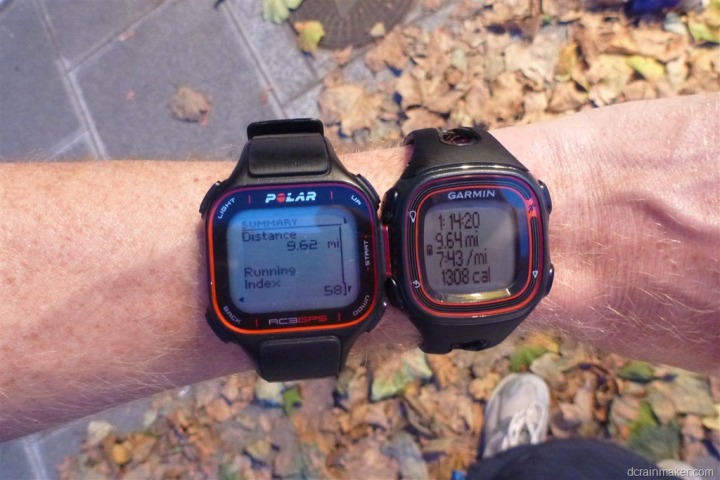
Meanwhile, The Girl found that the FR10 struggled a bit in one specific section with very tight typical European style alley/small street between stone buildings (one-car width alley with 5-6 story buildings) – where the FR310XT tracked just fine – resulting in a bit of a discrepancy (8.23 for the FR10 vs 8.43 with the FR310XT):
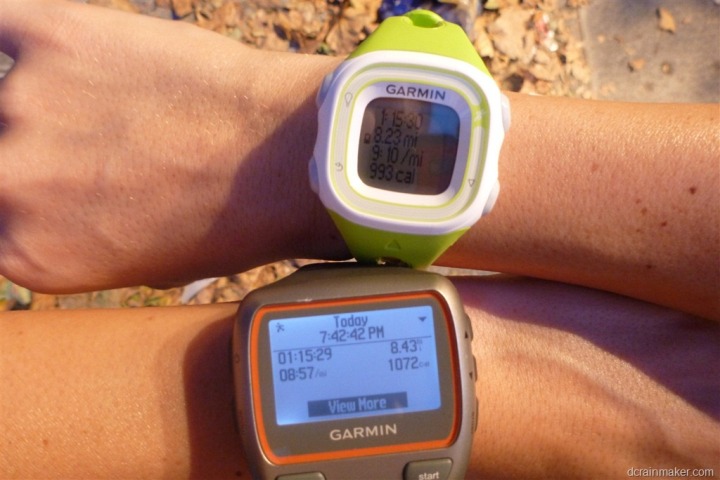
Overall however, we’ve found the unit to track well in most normal circumstances, enough that I’m just not worried about accuracy on the unit.
History:
The unit has a history menu on it which shows you past runs, as well as PR’s related to time and pace for your workouts.
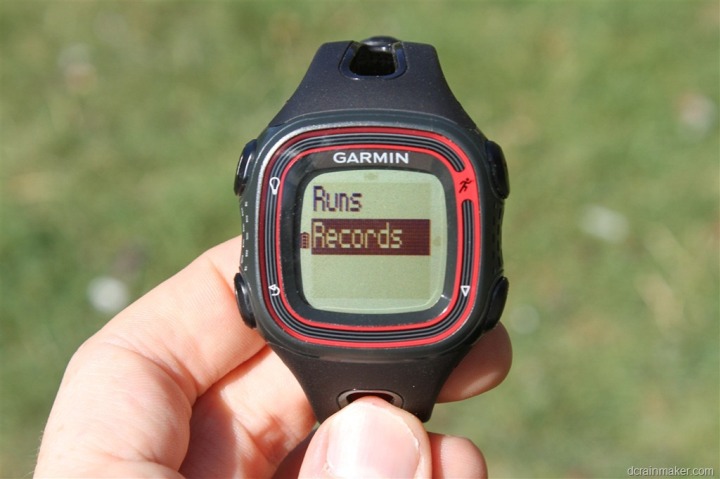
When you dive in you can view a given workout, including seeing all of its laps and splits for each lap.
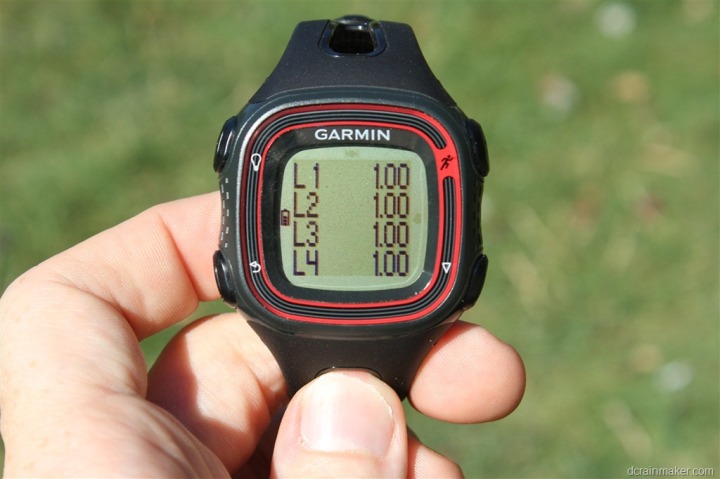
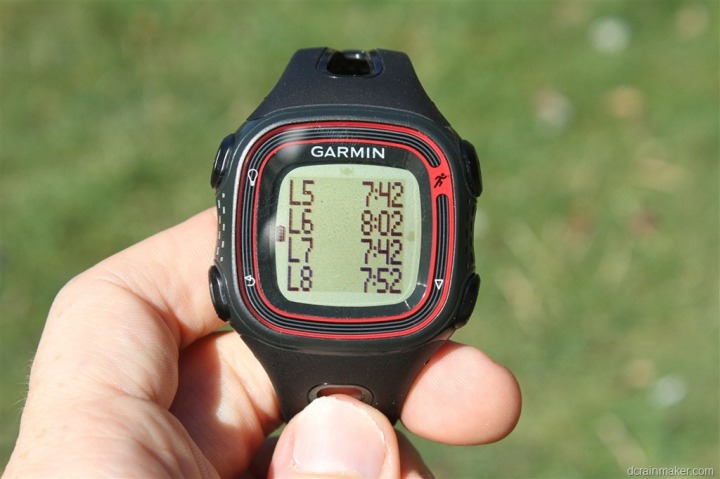
Then, it’ll show you PR’s such as your longest run, fastest mile, fastest 5K, fastest 10K and other bits of running trivia. However, they won’t pull from your existing Garmin Connect account – so it’ll only be stuff on this particular watch. Still, a nice nod to what we’ve seen on other watches like the Nike+ GPS that does this as well.
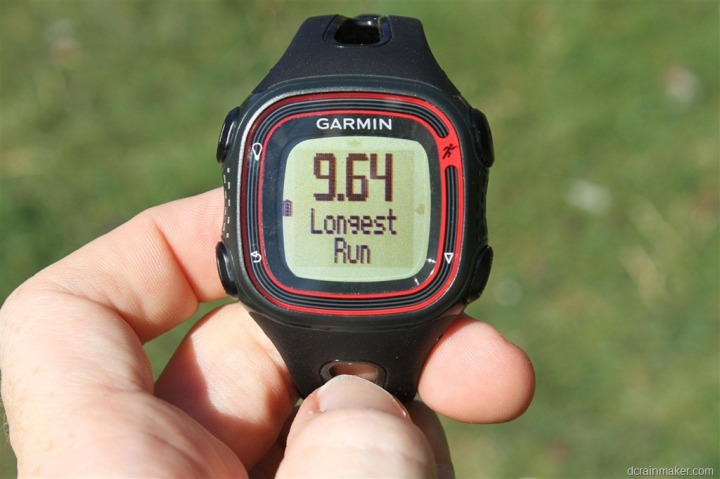
I did see a few quirks in the history menu with duplicate days, which I suspect is that it just enumerates every activity separately on a given day, as opposed to grouping all (for example) Friday workouts. Kinda odd, but a minor annoyance more than anything.
Use as a day to day watch:
The Garmin FR10 works as a day to day watch as well. While the unit only has 5 hours of active battery life for activities, it will stay in standby (time displaying) mode for five weeks. Meaning that if you run with it a few hours each week, it’ll easily stay in normal watch mode the rest of the time.
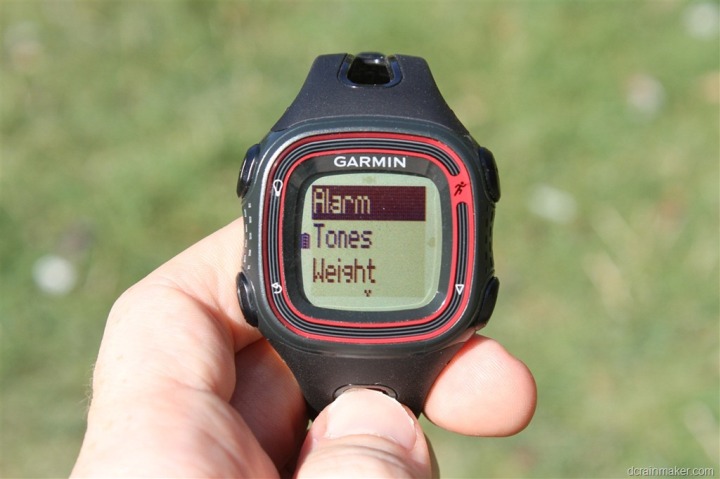
The watch will automatically display the time based on your current time zone, which is retrieved from GPS when you turn on the GPS receiver (to start an activity).
In addition to displaying the time, you can also configure a single alarm.
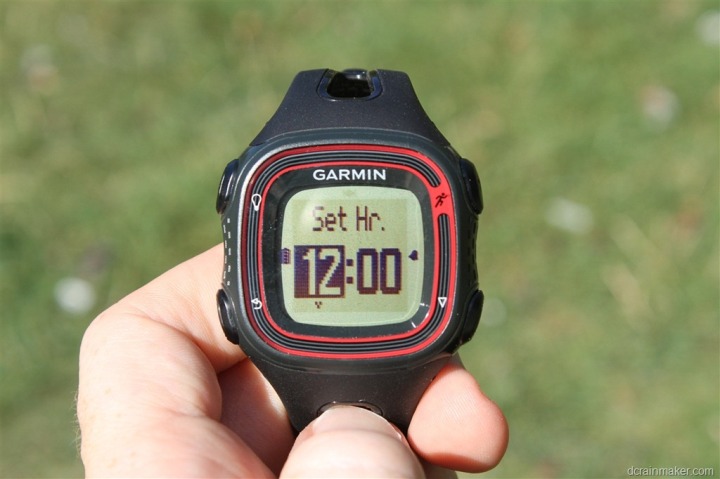
For display of time, you can choose either 12 hour or 24 hours. You cannot choose to display seconds while on the main watch screen – only hour/minutes and Month/Date (i.e. Aug 28).
Various Settings/Configuration Options of Note:
Just to cover a few final items that don’t really fit in any other category:
A) You can change the language to a slew of included languages
B) You can change from metric to statue for distance and pace
C) You can change from 12 hour to 24 hour clock mode (as noted above)
D) You can specify your weight (but not age or height), which then provides very basic calorie calculations, though interestingly as you can see above – they were nearly identical to that of the Polar RC3 doing calorie calculations with the heart rate monitor on. Fairly impressive.
E) You can specify two data pages with two data fields per data. No more, no less. This is not Burger King.
F) That is all.
Downloading and Software:
The Garmin FR10 supports uploading of workouts to Garmin Connect, using the supplied USB charging cable. To start the upload process, merely connect the cable to the watch and plug it into your computer (Mac or PC):
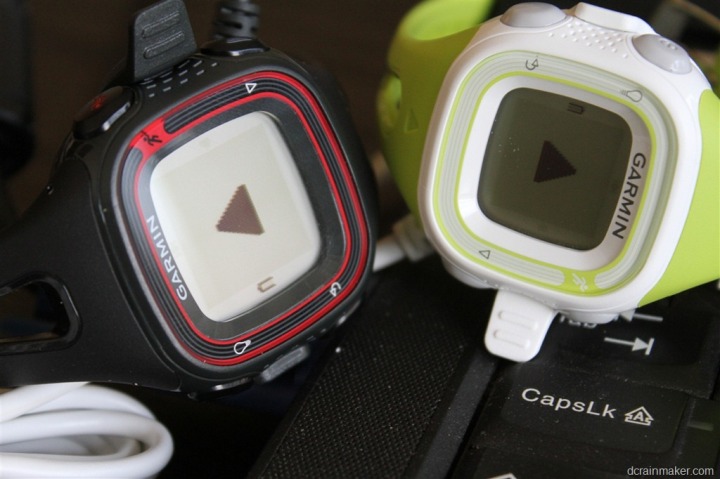
The watch will appear as a USB storage device – just like a USB hard drive/thumb drive.
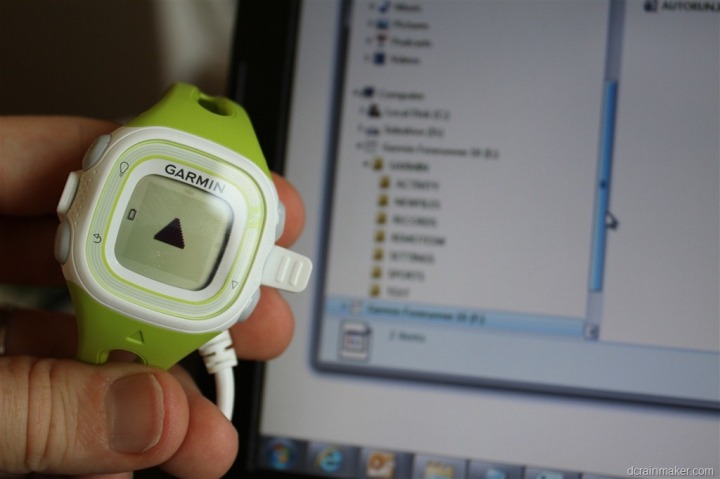
You can pick the files manually (which are in Garmin’s .FIT file format), or you can simply go to Garmin Connect and let Garmin Communicator (browser plugin) do the searching for you.
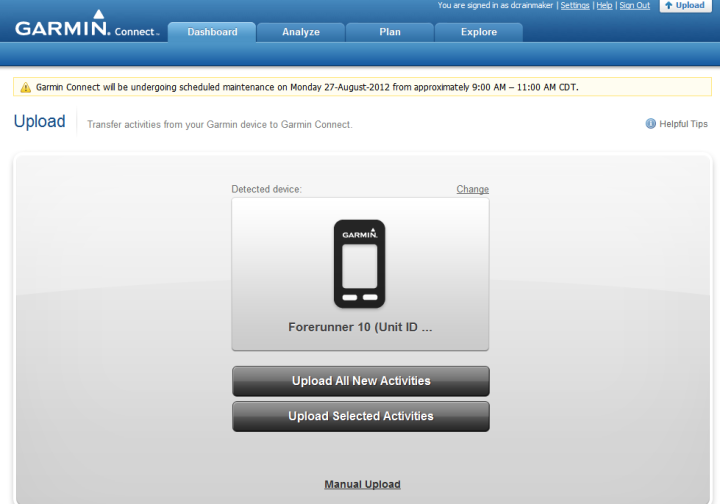
From here you’ll click to either upload all new activities – or select specific ones. In my case, I usually just tell it new ones only. Within a few seconds the upload process is complete, and you can see the list of activities:

To dive into a given activity, simply click ‘View Details’, which brings you to the main page for that given activity. Below you can see my Saturday evening run.
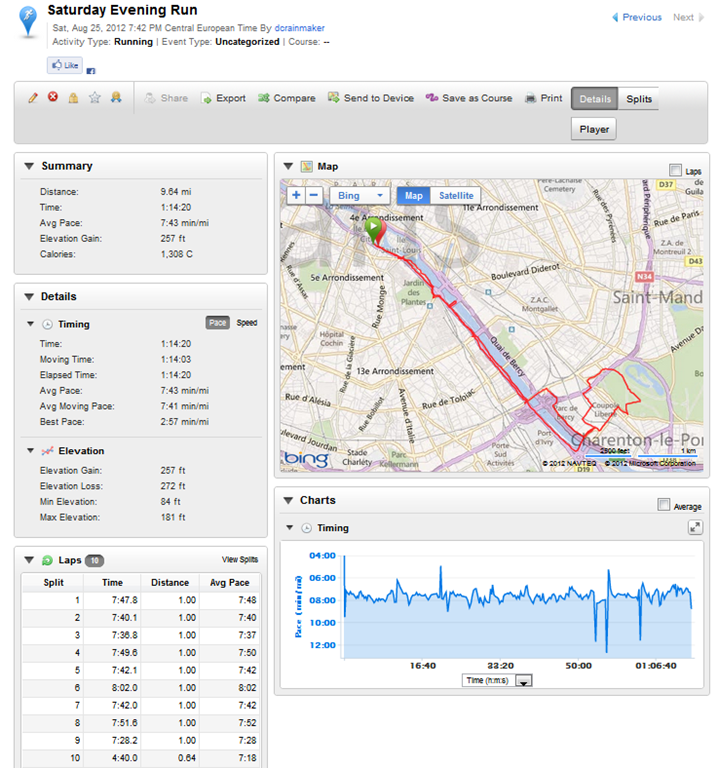
Along the left side are the high level stats for the run – from overall time, distance and pace – to elevation information. Elevation information on the FR10 comes via the GPS track. Meaning that it isn’t actually done/measured in the watch – but rather Garmin Connect figures it out based on known elevation data, by using the route.
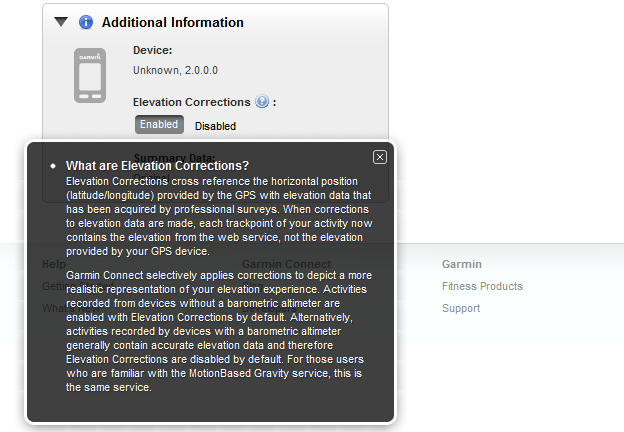
On the right side of the activity page is further details about your run. First up is the map. You can switch between Google or Bing as a provider, and then change to the various mapping formats that each service offers (satellite, hybrid, street map, etc…).
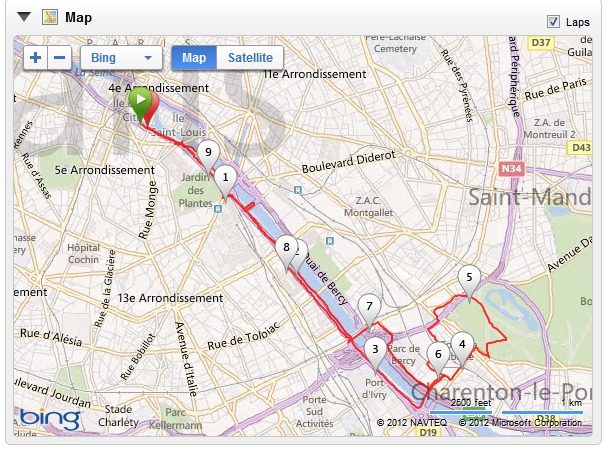
Continuing down the page is the pace graph, which shows your pace over the course of the run/bike.
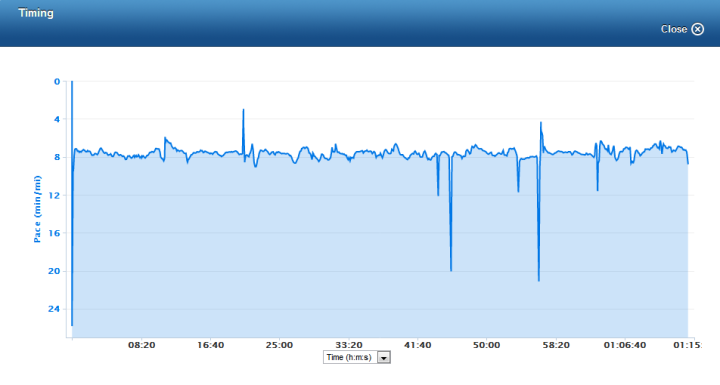
You can click over a given portion to see the pace, as well as highlight a section to dive into just that piece:
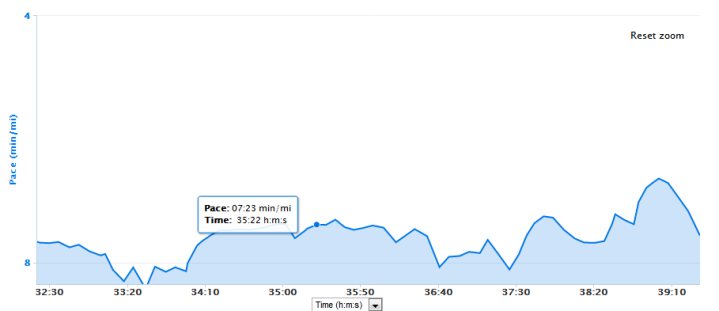
Now what’s interesting here is that after the pace graph there’s actually no further graphs. Typically there’s also an elevation graph here as well – but for reasons that are somewhat unclear to me that’s been turned off for the FR10 (yet you’ll still see total elevation ascent/descent on the left).
Next up is the splits tab, which allows you to see split information for each of the laps that you either pressed, or had auto-set:
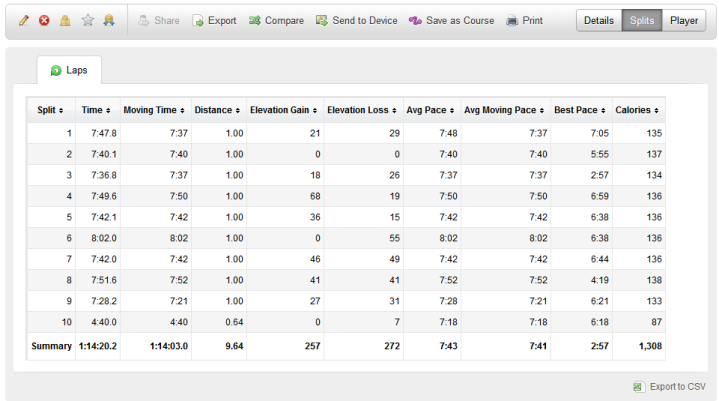
Lastly, you can click on the ‘Player’ tab to click a play button and have your run/bike replayed for you. It’ll show your location on the map, and your corresponding speed up above, as well as the elevation at that point in time. This is why it’s a bit puzzling to me that the elevation map isn’t available on the other page like normal.

In addition to single-activity analysis, you can also dive into a full calendar of all your previous activities, some basic activity graphing/reporting, and then also health graphing/reporting for connected weight devices (like the Tanita BC-1000 scale).
Now – what’s probably the most useful piece of Garmin Connect isn’t actually the activity logging itself – but the ability to search other peoples activities for routes, in particular, when you’re travelling outside your home turf. I’ve used this countless times to find running routes that might otherwise be in the middle of nowhere. But since there’s a gazillion Garmin users, and thus a gazillion people uploading runs – you’re pretty much bound to find a run somewhere.
Additionally, the PR (Personal Records) data that shows up on the watch also shows up on Garmin Connect. Though, I find it far from reliable. For example, it can’t seem to find any of my marathons, nor my 37-minute 10K PR or tons of 5K’s in the mid-upper teens. And why would it show the furthest distance as 9.6 miles when there’s clearly a half-marathon above it and dozens if not 50+ 20-miler runs? Sigh. As an FYI, cycling was just introduced yesterday as well.
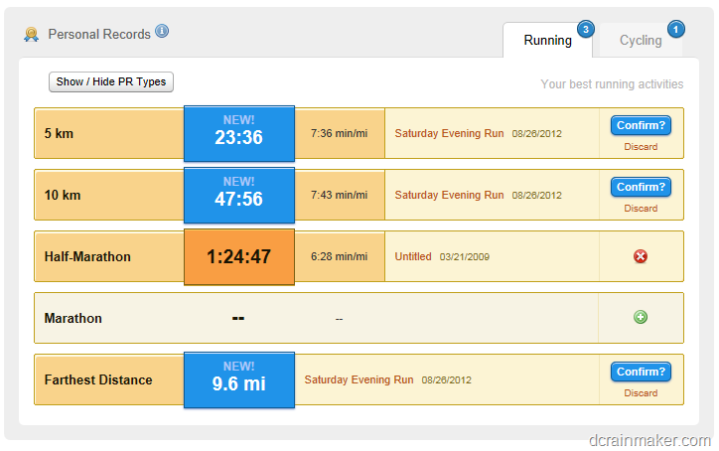
At the end of the day Garmin Connect is a good basic platform for sports activity analysis. It’s not really ideal for folks wanting more detail, or lots of analytic capabilities. But at the same time, the FR10 simply isn’t a watch too deep on details itself. Now, the FR10 does record a fair number of details, so you can go ahead and load your FR10 file into other apps (i.e. TrainingPeaks or Sport Tracks) and take it from there. Also, sometimes Garmin Connect can be a little bit buggy – but in general, I find it no more better or worse than other platforms out there from a bug quantity standpoint.
Accessories:
In short, the Garmin FR10 doesn’t really support or have any accessories. Since the unit doesn’t support ANT+ sensors, about the only thing you can buy for the watch is the standard Garmin Forerunner bike mount, which usually costs about $10.
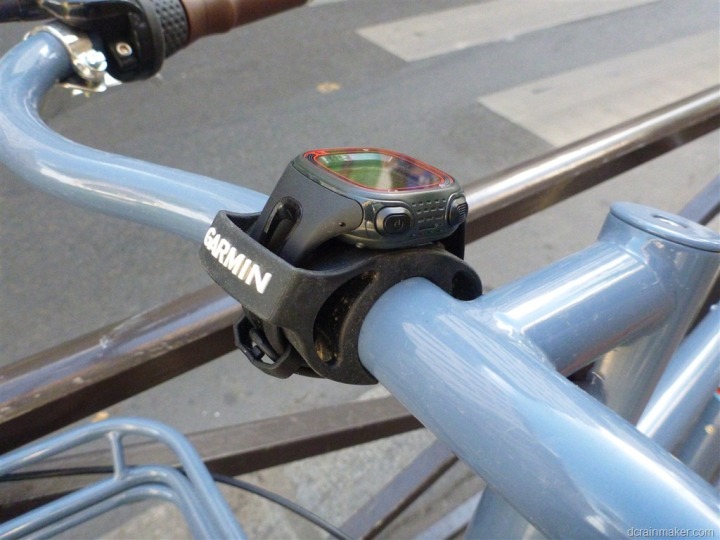
This allows you to wrap it around the handlebars of a bike and then wrap the watch around it as opposed to your wrist.
That’s about it on the accessories front!
Competitive Comparison Chart:
The Garmin FR10 clearly takes on the other ~$100 GPS watches in the market today. Head to head many of the core features and functionality aspects are very close. It’s the details that make the difference. Here’s a breakdown of where things stand (click to expand).
| Function/Feature | Garmin Forerunner 10 | Polar Ignite 3 | Garmin Forerunner 55 | Polar Ignite 2 | Polar Unite |
|---|
| Copyright DC Rainmaker - Updated March 24th, 2024 @ 12:36 pm New Window |
| Price | $129 | $329 | $199 | $229 | $149 |
| Product Announcement Date | AUG 28, 2012 | Nov 8th, 2022 | June 2nd, 2021 | Mar 24th, 2021 | June 30th, 2020 |
| Actual Availability/Shipping Date | SEP 2012 | Nov 8th, 2022 | June 2nd, 2021 | Mar 2021 | July 2020 |
| GPS Recording Functionality | Yes | Yes | Yes | Yes | Only via Phone Connected GPS |
| Data Transfer | USB | USB, BLUETOOTH SMART | USB, Bluetooth Smart | USB, BLUETOOTH SMART | USB, BLUETOOTH SMART |
| Waterproofing | 50 meters | Yes - 30m | 50 meters | Yes - 30m | Yes - 30m |
| Dive/Snorkel Feature | | No | | | |
| Battery Life (GPS) | 5 Hours | Up to 30 hours | 20 hours | Up to 20 hours | Up to 50hrs with phone GPS (4 days standby) |
| Solar Charging | | No | | | |
| Recording Interval | Smart | 1s | 1s/Smart | 1s | 1s |
| Dual-Frequency GNSS | | Yes | | | |
| Alerts | Sound/Visual | Vibrate/Visual | Sound/Visual/Vibrate | Vibrate/Visual | Vibrate/Visual |
| Display Type | | AMOLED | | | |
| Backlight Greatness | OK | Great | Great | Great | Great |
| Ability to download custom apps to unit/device | No | No | Yes (all Connect IQ Apps) | No | No |
| Acts as daily activity monitor (steps, etc...) | No | Yes | Yes | Yes | Yes |
Voice Integration | Garmin Forerunner 10 | Polar Ignite 3 | Garmin Forerunner 55 | Polar Ignite 2 | Polar Unite | | Has Mic/Speaker | | No | | | |
| Can make/receive calls | | No | | | |
| Voice Assistant | | No | | | |
Music | Garmin Forerunner 10 | Polar Ignite 3 | Garmin Forerunner 55 | Polar Ignite 2 | Polar Unite | | Can control phone music | No | Yes | Yes | Yes | No |
| Has music storage and playback | nO | No | No | No | No |
| Streaming Services | | No | No | No | No |
Payments | Garmin Forerunner 10 | Polar Ignite 3 | Garmin Forerunner 55 | Polar Ignite 2 | Polar Unite | | Contactless-NFC Payments | | No | No | No | No |
Connectivity | Garmin Forerunner 10 | Polar Ignite 3 | Garmin Forerunner 55 | Polar Ignite 2 | Polar Unite | | Bluetooth Smart to Phone Uploading | No | Yes | Yes | Yes | Yes |
| Phone Notifications to unit (i.e. texts/calls/etc...) | No | Yes | Yes | Yes | Yes |
| Live Tracking (streaming location to website) | No | No | Yes | No | No |
| Group tracking | | No | No | No | No |
| Emergency/SOS Message Notification (from watch to contacts) | No | No | Yes (via phone) | No | No |
| Built-in cellular chip (no phone required) | No | No | No | No | No |
Cycling | Garmin Forerunner 10 | Polar Ignite 3 | Garmin Forerunner 55 | Polar Ignite 2 | Polar Unite | | Designed for cycling | Barely | Yes | Yes | Yes | Yes |
| Power Meter Capable | No | No | No | No | No |
| Speed/Cadence Sensor Capable | No | No | Yes | No | No |
| Strava segments live on device | No | No | No | No | No |
| Crash detection | | No | Yes | No | No |
Running | Garmin Forerunner 10 | Polar Ignite 3 | Garmin Forerunner 55 | Polar Ignite 2 | Polar Unite | | Designed for running | Yes | Yes | Yes | Yes | Yes |
| Footpod Capable (For treadmills) | No | No | YES (ALSO HAS INTERNAL ACCELEROMETER) | No | No (but has accelerometer for indoor running) |
| Running Dynamics (vertical oscillation, ground contact time, etc...) | No | No | No | No | No |
| Running Power | | No | No | No | No |
| VO2Max Estimation | No | Yes | Yes | Yes | Yes |
| Race Predictor | No | No | Yes | No | No |
| Recovery Advisor | No | No | Yes | No | No |
| Run/Walk Mode | Yes | No | Yes | No | No |
| Track Recognition Mode | | No | Yes | No | |
Swimming | Garmin Forerunner 10 | Polar Ignite 3 | Garmin Forerunner 55 | Polar Ignite 2 | Polar Unite | | Designed for swimming | NO (PROTECTED THOUGH JUST FINE) | Yes | Yes | Yes | Sorta (waterproof but HR only tracking) |
| Openwater swimming mode | N/A | Yes | N/A | Yes | No |
| Lap/Indoor Distance Tracking | N/A | Yes | Yes | Yes | No |
| Record HR underwater | N/A | Yes | Yes | Yes | Yes |
| Openwater Metrics (Stroke/etc.) | N/A | Yes | N/A | Yes | No |
| Indoor Metrics (Stroke/etc.) | N/A | Yes | Yes | Yes | No |
| Indoor Drill Mode | N/A | No | | No | No |
| Indoor auto-pause feature | N/A | Yes | | Yes | No |
| Change pool size | N/A | Yes | Yes | Yes | No |
| Indoor Min/Max Pool Lengths | N/A | 20M/Y to 250 m/y | | 20M/Y to 250 m/y | N/A |
| Ability to customize data fields | N/A | Yes | Yes | Yes | Yes |
| Captures per length data - indoors | N/A | Yes | Yes | Yes | No |
Triathlon | Garmin Forerunner 10 | Polar Ignite 3 | Garmin Forerunner 55 | Polar Ignite 2 | Polar Unite | | Designed for triathlon | No | No | No | No | No |
| Multisport mode | N/A | No | No | No | No |
Workouts | Garmin Forerunner 10 | Polar Ignite 3 | Garmin Forerunner 55 | Polar Ignite 2 | Polar Unite | | Create/Follow custom workouts | No | Yes | Yes | Yes | Yes |
| On-unit interval Feature | No | Sorta (offers structured workouts) | Yes | Sorta (offers structured workouts) | Sorta (offers structured workouts) |
| Training Calendar Functionality | No | Has daily suggested workouts | Yes | Has daily suggested workouts | Sorta (offers daily workouts) |
Functions | Garmin Forerunner 10 | Polar Ignite 3 | Garmin Forerunner 55 | Polar Ignite 2 | Polar Unite | | Auto Start/Stop | Yes | No | Yes | | |
| Virtual Partner Feature | Pace Alerts | No (but can give out of zone information) | Virtual Pacer | No (but can give out of zone information) | No (but can give out of zone information) |
| Virtual Racer Feature | No | Yes (Race Pace) | No | No | No |
| Records PR's - Personal Records (diff than history) | Yes | No | Yes | No | No |
| Tidal Tables (Tide Information) | No | No | No | No | No |
| Weather Display (live data) | No | Yes | Yes | Yes | No |
Navigate | Garmin Forerunner 10 | Polar Ignite 3 | Garmin Forerunner 55 | Polar Ignite 2 | Polar Unite | | Follow GPS Track (Courses/Waypoints) | No | No | No | No | No |
| Markers/Waypoint Direction | No | No | No | No | No |
| Routable/Visual Maps (like car GPS) | No | No | No | No | No |
| Back to start | No | No | No | No | No |
| Impromptu Round Trip Route Creation | No | No | No | No | No |
| Download courses/routes from phone to unit | No | No | No | No | No |
Sensors | Garmin Forerunner 10 | Polar Ignite 3 | Garmin Forerunner 55 | Polar Ignite 2 | Polar Unite | | Altimeter Type | None | GPS | No | GPS | None |
| Compass Type | N/A | N/A | None | N/A | N/A |
| Optical Heart Rate Sensor internally | | Yes | Yes | Yes | Yes |
| SpO2 (aka Pulse Oximetry) | | No | No | No | No |
| ECG Functionality | | NO | No | NO | |
| Heart Rate Strap Compatible | No | Yes | Yes | Yes | Yes |
| ANT+ Heart Rate Strap Capable | No | No | Yes | No | No |
| ANT+ Speed/Cadence Capable | No | No | Yes | No | No |
| ANT+ Footpod Capable | No | No | Yes | No | No |
| ANT+ Power Meter Capable | No | No | No | No | No |
| ANT+ Lighting Control | No | No | No | No | No |
| ANT+ Bike Radar Integration | No | No | No | No | No |
| ANT+ Trainer Control (FE-C) | no | No | No | No | No |
| ANT+ Remote Control | No | No | No | No | No |
| ANT+ eBike Compatibility | No | No | No | No | No |
| ANT+ Gear Shifting (i.e. SRAM ETAP) | | No | No | No | No |
| Shimano Di2 Shifting | No | No | No | No | No |
| Bluetooth Smart HR Strap Capable | No | Yes | No | Yes | Yes |
| Bluetooth Smart Speed/Cadence Capable | No | No | No | No | No |
| Bluetooth Smart Footpod Capable | No | No | No | No | No |
| Bluetooth Smart Power Meter Capable | No | No | No | No | No |
| Temp Recording (internal sensor) | No | No | No | No | No |
| Temp Recording (external sensor) | No | No | No | No | No |
Software | Garmin Forerunner 10 | Polar Ignite 3 | Garmin Forerunner 55 | Polar Ignite 2 | Polar Unite | | PC Application | GTC | Polar Flowsync - Windows/Mac | Garmin Express (PC/Mac) | Polar Flowsync - Windows/Mac | Polar Flowsync - Windows/Mac |
| Web Application | Garmin Connect | Polar Flow | Garmin Connect | Polar Flow | Polar Flow |
| Phone App | Garmin Connect Mobile | iOS/Android | iOS/Android | iOS/Android | iOS/Android |
| Ability to Export Settings | No | No | No | No | No |
Purchase | Garmin Forerunner 10 | Polar Ignite 3 | Garmin Forerunner 55 | Polar Ignite 2 | Polar Unite | | Amazon | Link | Link | Link | Link | Link |
| Backcountry.com | | | Link | | |
| REI | | | Link | | |
DCRainmaker | Garmin Forerunner 10 | Polar Ignite 3 | Garmin Forerunner 55 | Polar Ignite 2 | Polar Unite | | Review Link | Link | Link | Link | Link | Link |
In my opinion, the Garmin FR10 is actually at a bit of an odd price point. Had Garmin wanted to sweep the category, they would have sold it for $100 – like many of the other units. Instead though, they priced it $30 higher – which conflicts with some other GPS units (namely the Timex Global Trainer) at $130ish. Further, just $20 more and you’ve got a wealth of options in the $150 to $170 range – all with vastly more functionality (the TGT at $130 is also exponentially more advanced, but significantly larger).
(Note: I included the Soleus 2.0 in there since the price is often down in the $120 range, despite a retail price of $150)
The question is – can they get people to spend $30 more from $99 to $129? At the moment, I think the answer comes down to four additional features that the FR10 has that the other $100 watches don’t: Virtual Pacer, Run/Walk, Download History, and Auto Pause. The first two are most heavily targeted at runners newer to the sport, and thus runners most likely to purchase this watch. In short, would you pay $7.50 per feature over the $99 watches?
Now, I think if Timex were to come along and offer a download cable for their $99 Marathon GPS and have it upload to TrainingPeaks – it’d be a fairly competitive situation given the depth of TrainingPeaks compared to Garmin Connect. Meanwhile, the current download option on the Soleus 2.0 just isn’t competitive with anything given how horrible the software is.
Oh, and if you’re looking at the New Balance GPS Runner watch – it’s the same watch as the Soleus 1.0. Really, exact same watch, just they scratched off Soleus and put New Balance. So anything that applies to that, applies to the New Balance. Make sense?
Pros and Cons:
Here’s the quick and dirty version of what I think of the watch (for those that made it this far in scrolling):
Pros:
– Inexpensive, cheapest GPS watch Garmin’s made
– Legit waterproofing, up to 50 meters
– Easy to use
– Virtual Pacer, Run/Walk and Auto Pause included (usually on higher end watches)
– Garmin Connect upload capability
– Very very small, especially the women’s version
Cons:
– Two different sized charging docs could be pain for couples
– Only one user profile per watch (for calorie info)
– No ANT+ sensor connectivity for heart rate or indoor treadmills
– Cycling mode is so-so at best
Summary:
Overall I think the FR10 makes for a solid GPS watch for someone wanting to spend around $100. At that price point you’ll sacrifice functionality (even over cell phone apps), but you will gain durability and waterproofing. The Garmin Connect software suite is adequate for most beginner to intermediate runners, or advanced runners that don’t care about the analytics side as much.
At that price point ($100-$130) it clearly delivers more than any other GPS integrated watch out there, and I think the extra $30 over the $99 watches is worth it for the download, virtual pacer, and run/walk features.
Expect to see the Garmin FR10 in the Garmin store in Chicago near-immediately, and then in your local running stores sometime this fall. Given the units are done and the firmware complete – I don’t think you’ll see a delay like other watches. Just my guess.
Found this review useful? Or just want a sweet deal?
Hopefully you found this review useful. At the end of the day, I’m an athlete just like you looking for the most detail possible on a new purchase – so my review is written from the standpoint of how I used the device. The reviews generally take a lot of hours to put together, so it’s a fair bit of work (and labor of love). As you probably noticed by looking below, I also take time to answer all the questions posted in the comments – and there’s quite a bit of detail in there as well.
I’ve partnered with Clever Training to offer all DC Rainmaker readers exclusive benefits on all products purchased. You can read more about the benefits of this partnership here. You can pickup the FR10 through Clever Training using the link below. By doing so, you not only support the site (and all the work I do here) – but you also get to enjoy the significant partnership benefits that are just for DC Rainmaker readers. And, since this item is more than $75, you get free US shipping as well.
Garmin FR10 Lime Green (smaller women’s size) – Change drop-down to show color
Garmin FR10 Bright Pink (smaller women’s size) – Change drop-down to show color
Garmin FR10 Purple (smaller women’s size) – Change drop-down to show color
Garmin FR10 Silver/Black (smaller women’s size) – Change drop-down to show color
Garmin FR10 Red/Black (slightly larger, men’s variant) – Change drop-down to show color
Garmin FR10 Orange (slightly larger, men’s variant) – Change drop-down to show color
Additionally, you can also use Amazon to purchase the unit (all colors shown after clicking through to the left) or accessories (though, no discount). Or, anything else you pickup on Amazon helps support the site as well (socks, laundry detergent, cowbells). If you’re outside the US, I’ve got links to all of the major individual country Amazon stores on the sidebar towards the top.
As you’ve seen throughout the review there are numerous compatible accessories for the unit. I’ve consolidated them all into the below chart, with additional information (full posts) available on some of the accessories to the far right. Also, everything here is verified by me – so if it’s on the list, you’ll know it’ll work. And as you can see, I mix and match accessories based on compatibility – so if a compatible accessory is available at a lower price below, you can grab that instead.
| Product | Street Price | Amazon |
| 2013 Recommendations: Running GPS Watches | | |
| 2014 Summer Recommendations: Running Watches | | |
| Garmin Bike Mount Kit (for mounting any watch onto handlebars)
$10.00 | $10.00 | Amazon |
| Garmin FR10 Charging Cable (Large)
$19 | $19 | Amazon |
| Garmin FR10 Charging Cable (Small)
$19 | $19 | Amazon |
Thanks for reading! And as always, feel free to post comments or questions in the comments section below, I’ll be happy to try and answer them as quickly as possible. And lastly, if you felt this review was useful – I always appreciate feedback in the comments below. Thanks!
Finally, I’ve written up a ton of helpful guides around using most of the major fitness devices, which you may find useful in getting started with the devices. These guides are all listed on this page here.



















































































